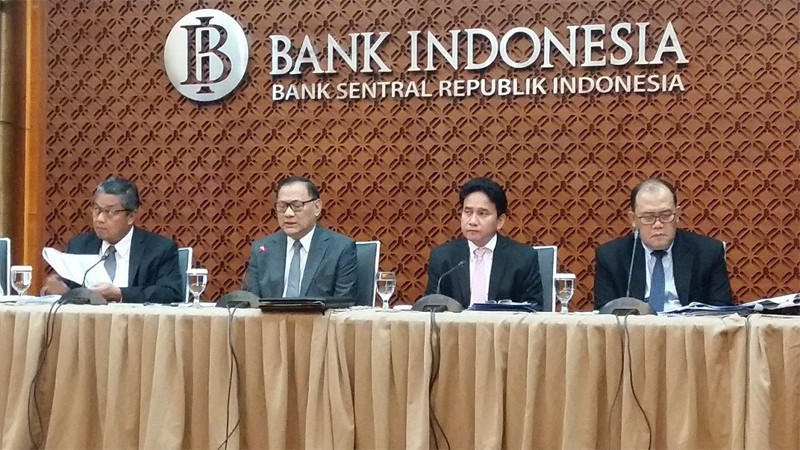BI's policy rate at crossroads
BI’s signal seems to be a “confession of sin” of the ineffectiveness of benchmark interest rate policy (until the BI rate was replaced with the 7-day reverse repo rate) on economic growth.
Change Size
 Guardians of monetary policy: Bank Indonesia deputy governor Perry Warjiyo (left), governor Agus Martowardojo (second left), senior deputy governor Mirza Adityaswara (second right) and deputy governor Hendar speak at a press conference at the central bank office in Jakarta. (JP/Anton Hermansyah)
Guardians of monetary policy: Bank Indonesia deputy governor Perry Warjiyo (left), governor Agus Martowardojo (second left), senior deputy governor Mirza Adityaswara (second right) and deputy governor Hendar speak at a press conference at the central bank office in Jakarta. (JP/Anton Hermansyah)
E
ntering 2017, the global economy is still filled with an atmosphere of uncertainty. United States president-elect Donald Trump’s tendency toward protectionist economic policies, China’s economic slowdown, the debt crisis in European countries, the Brexit phenomenon and the weakening of key commodity prices in the international market will most likely affect the global economy.
In the financial sector, the US Federal Reserve (central bank) has signaled to hike its benchmark interest rate three times in 2017 and twice in the next year. Those signals will undoubtedly trigger negative sentiments in the form of liquidity migration to the US financial markets that are seen as the safest place of any uncertainty.
Regarding the domestic sphere, the inflation rate will be skyrocketing due to the rise of administered prices, such as basic electricity tariffs, gasoline and some volatile food commodities. Consequently, the inflation target range of 3 to 5 percent throughout the current year could not be reached.
Therefore, the central bank, Bank Indonesia (BI), is still looking for the most appropriate monetary policy to anticipate the above factors. In early January, for example, BI signaled it would no longer rely on its benchmark interest rate to boost economic growth. Instead, the benchmark interest rate will be directed to maintain financial system stability.
BI’s signal seems to be a “confession of sin” of the ineffectiveness of benchmark interest rate policy (until the BI rate was replaced with the 7-day reverse repo rate) on economic growth. The challenging question is whether the failure of the benchmark interest rate policy will be repeated in the case of the financial system stability target.
By definition, the reverse repo rate is the interest rate on the sale of government debt securities by BI to banks under the condition of being able to be bought back again by BI within a certain period. In this case, the interest rate on the government debt securities market becomes an “anchor” of the policy.
Theoretically, the interest rates on government securities and banking rates should normally move together in the same direction. The change in banking interest rates is seen by investors as substitution or the opportunity cost of holding government securities, vis-à-vis. Consequently, the relative value of the two interest rates will be relatively constant.
In implementing the repo rate, BI seems to implicitly assume that the interest rates’ pass-through mechanism works perfectly. From the central bank’s point of view, the change in the repo rate will proportionately be accompanied by the changes in banking interest rates. This presumption can, of course, be missed.
Refer to the experiences in the previous year — the banking interest rates were rigid. The benchmark interest rate cut (150 basis points) was not followed equally by the decrease in the borrowing and lending interest rates (100 and 70 basis points respectively). It means that the banking interest rates were persistent, implying a liquidity crunch.
In the policy strand, the use of the repo rate as the intermediate target of monetary policy fits to the economy when people are responsive to the interest rates. The money market players are much more sensitive to the interest rate movements than producers and consumers in the real sector.
Consumers have the choices of holding money or buying goods/ services. Similarly, producers deal with the fluctuations in input prices and selling-price of their products. Consequently, the inflation rate is more suitable as the short-term indicator of monetary policy rather than the interest rate.
Unfortunately, the inflation rate is not accommodated in determining the repo rate. Again, BI assumes that the Fisher effect exists; the change in nominal interest rates in the money market perfectly represents the change in inflation rates. Without considering the inflation rate, the repo rate is more in favor of the financial markets rather than the goods market.
Furthermore, in an open economy, the economic actors are also more sensitive to exchange rate movements. The domestic manufacturers deal with the imported capital goods. Meanwhile, households are deeply concerned with the exchange rate in relation to the imported consumer goods.
More ironically, BI does not explicitly incorporate the exchange rate target in formulating the repo rate. As a consequence, economic actors (including the central bank itself ) do not have a guide for a foreign exchange rate that could be used to make an economic decision.
Again and again, there is an imposed assumption that the interest rate parity is automatically satisfied. The movement of the benchmark interest rate is presumably in line with the expectation of exchange rate changes in the future.
In a broader scope, the repo rate cannot be separated from the benchmark interest rates set by other countries, especially the Fed rate. In increasingly integrated financial markets, a little bit of interest rate differential is powerful enough to make investors carry off their funds out of the country, which represses again the rupiah.
The problem is more complicated when inflation and exchange rate stabilization is achieved together. An empirical study by Taguchi and Sohn (2014) concludes that the degree of exchange rate pass-through is quite weak. It means that exchange rate movements are not represented fully by the fluctuation in inflation rates.
In these circumstances, the effectiveness of the repo rate in controlling liquidity and interest rates in the money market is always related to the issue of inflation and exchange rate fluctuations. Consequently, the tasks assigned to the repo rate in guarding the value of the rupiah will be more severe.
To sum up, the repo rate is at a crossroads. The Board of Governors meeting to determine the benchmark interest rate as the opening stance of 2017 monetary policy on Jan. 18 to 19, therefore, is the critical point.
As long as the interest rate pass-through, Fisher effect, interest rate parity, and exchange rate pass-through entirely hold, the impact of the benchmark interest rate policy on financial system stability will be effective. Otherwise, the benchmark interest rate policy becomes a disincentive for economic activities in the real sector.
***
The writer is research director at the Socio-Economic & Educational Business Institute (SEEBI) Jakarta and lecturer at the School of Economics, State University of Jakarta. The views expressed are his own.
---------------
We are looking for information, opinions, and in-depth analysis from experts or scholars in a variety of fields. We choose articles based on facts or opinions about general news, as well as quality analysis and commentary about Indonesia or international events. Send your piece to community@jakpost.com. For more information, click here.









